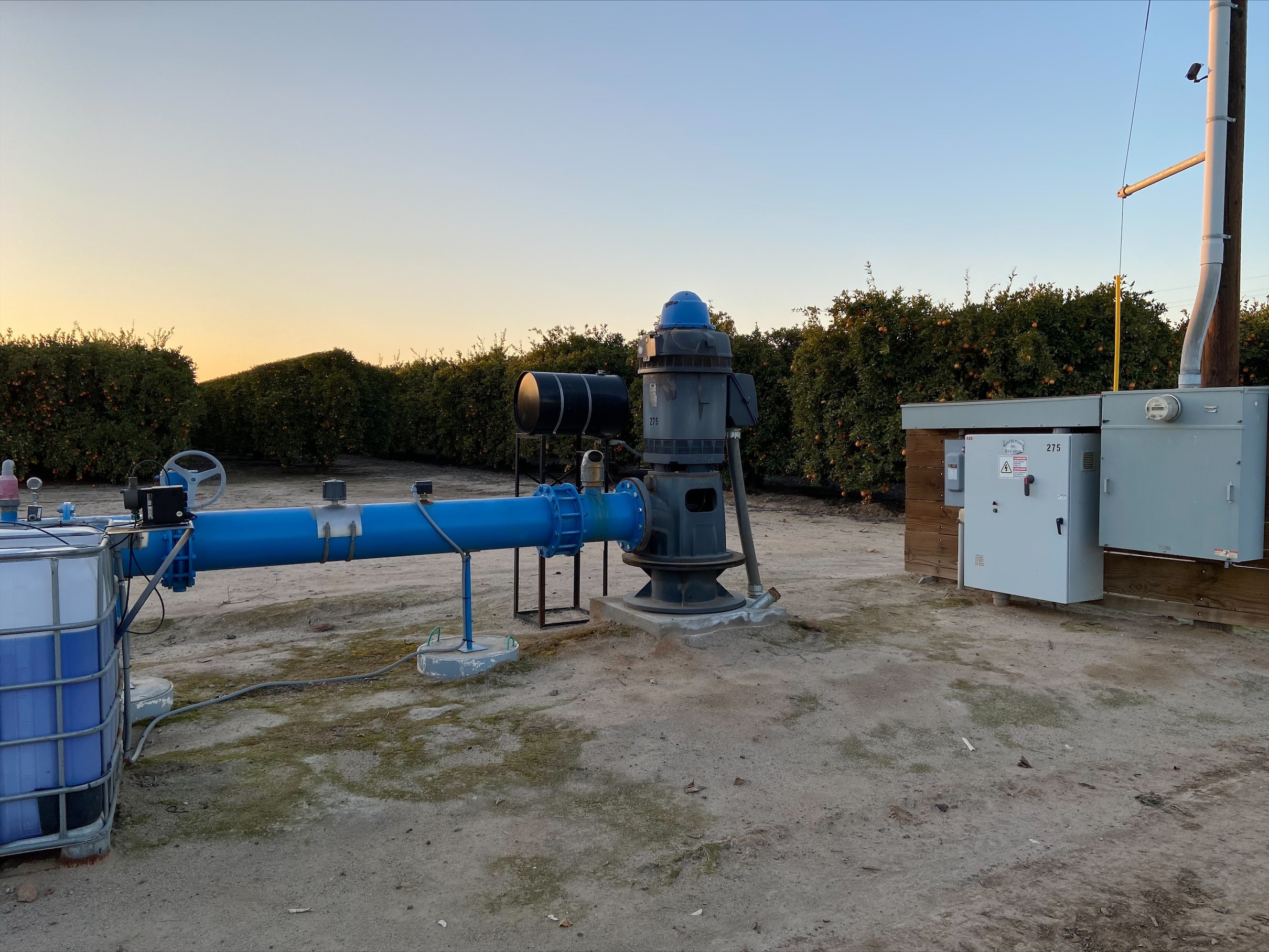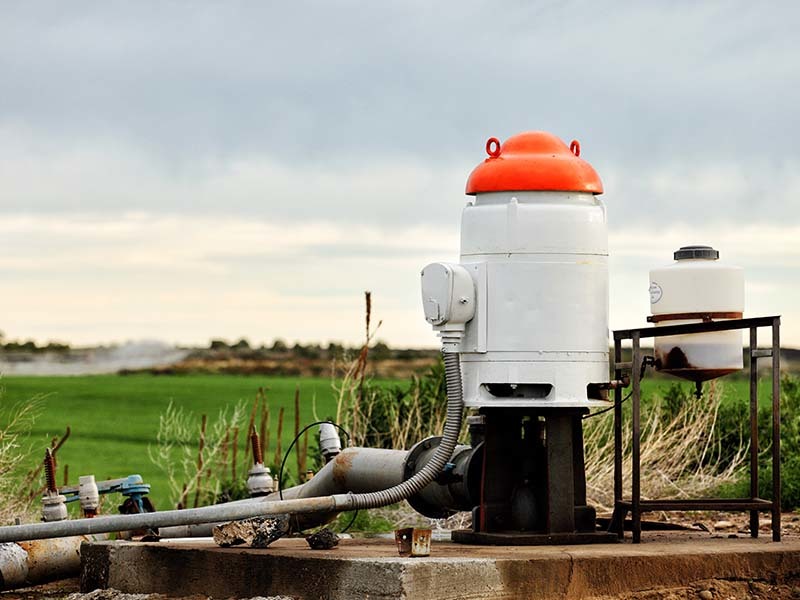The growing water scarcity in the western United States has led to an increased dependency on groundwater from wells. With regulatory pressure on groundwater, such as California’s Sustainable Groundwater Management Act (SGMA), and the increased cost associated with the energy required to extract water, it is a good time to discuss the efficiency of wells. A loss in well efficiency and not meeting your irrigations system’s design flow can increase the cost of pumping and lower crop yields. The following article will discuss drilled wells, the causes for well performance that decline over time, and how to keep wells running at the design flow rate.
Let us begin with the anatomy of a well in its most basic form. The most common well type in the western United States agriculture is a drilled well. Basically, a drilled well has three major parts: the casing, the pump, and the cap. Several other components play roles too, including screens, adapters, electric, bentonite grout, gravel, etc. Those will not be discussed in detail in this article.
The casing is the tubular structure that is placed in the newly drilled well to maintain the opening. Most well casings are constructed of metal, steel, or cast iron, and perforations are made at the lowest point for the water to pass through and to be delivered to the surface. On the surface, a motor that leads to a pump at the bottom of the well pushes water to the surface. The unique properties of water carry elements and nutrients that make well structures susceptible to biomatter, corrosion, deterioration, and scale build up.
The pump is the device that does exactly as it suggests: it pumps the water upward from the source to the surface for irrigation. Pumps come in a large variety of sizes, horsepower, and quality. The factors that determine which pump to use depends on the depth of the well, the distance from the well to the destination, and the expected demand of the crops.
The cap, usually made of metal, covers the top of the casing. It may be a very small part overall but is an extremely important one. A properly installed well cap separates potential pollutants and everything from water run-off, bugs, vermin, rodents, and reptiles from wreaking havoc and contamination. With those larger potential contaminants excluded, there must be a focus on small and bacterial issues that can occur.

As mentioned above, biomatter, corrosion, deterioration, and scale buildup can create a clogging issue over time. Clogged perforations and pipes can result in a reduction or total elimination of water discharge from the well, eventually leading to pump failure. Partially clogged perforations are particularly problematic since they reduce irrigation design flow but can easily go unnoticed until pump failure. Partial clogging of perforations is nearly impossible to diagnose without scoping the well, but you can detect it if you measure timed water flow rates from the well. Scoping a well is much like an endoscopy or colonoscopy at a physician’s office; it is a scope that can be fed deep into a well to inspect surfaces for issues.
Waterborne clogging also affects irrigation beyond the well systems, such as biomatter, scaling, and iron and hydrogen sulfide slime. When it comes to biomatter, filtration can greatly reduce plugging problems in the field. However, algae and other small plants and animals that live in or seek water can still pass through the filters. Microbes that pass through the filters can continue to grow inside the system. Some organisms can build up in numbers, often forming clumps within the tubing at the point where water enters the well.
Scaling may be caused by calcium or iron found in the water. These elements, usually associated with limestone or iron oxides, are often dissolved in the groundwater that is pumped into the well. Using this water for irrigation without treatment for calcium or iron can lead to scaling and ultimately plug the wells or irrigation system pipes. Iron-rich water leads to the formation of iron bacteria, which converts soluble iron to insoluble iron precipitates. The result is a red, yellow, or tan slime in the drip lines and wells. Iron concentrations of 0.2 parts per million (ppm) are sufficient to support bacterial growth. Once there is waterborne clogging, there is a not a quick and easy fix and not all fixes work with each issue or well.
Well clean-outs are not as simple as pouring bleach or the leading “clog-busting product” down your well and waiting for it to perform better. The process starts with a water analysis report from our Kurita America labs to evaluate the water qualities and then create a prescribed treatment plan, which is dependent on the results and needs of the individual well. The first phase generally works on the salt and mineral buildup in the pipes and perforations. This is done by using a proprietary blend of acids to carefully lower the pH to the desired level that varies based on conditions and flush through the system for as much as 24 hours. The endpoint determined by sampling.
The second phase works on biomatter and bacteria that may be forming in the water below the surface. This is done by using a proprietary blend of biocides appropriate for the issue and reaching a set residual level and flush through the system for as much as 24 hours. The endpoint is determined by sampling. Once completed, the results can be seen and evaluated using well videoscope photography and video from before and after. More importantly, a well flow design measurement test can ensure that the well is flowing at maximum efficiency. A well that is flowing at its design flow rate can operate more efficiently, saving money by reducing energy cost to the pump and improving yields by effectively irrigating your crop.
Regulatory pressure and increases costs are some of the reasons to have a problem well clean-out. To keep your crop yield strong, remember the basic anatomy of a drilled well, the causes for well performance that decline over time, and how to keep wells running at the design flow rate.
Contact Kurita America today to learn more about how we can help you with your most complex challenges to deliver optimal results.

